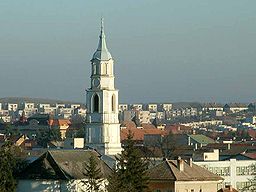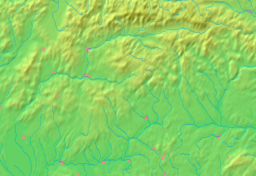Felsőpokorágy
| Rimavská Sobota | ||
| Rimaszombat | ||
| Town | ||
|
Panorama of Rimavská Sobota
|
||
|
|
||
| Official name: Rimavská Sobota | ||
| Country | Slovakia | |
|---|---|---|
| Region | Banská Bystrica | |
| District | Rimavská Sobota | |
| Tourism region | Gemer | |
| River | Rimava | |
| Elevation | 208 m (682 ft) | |
| Coordinates | 48°22′52″N 20°00′52″E / 48.38111°N 20.01444°ECoordinates: 48°22′52″N 20°00′52″E / 48.38111°N 20.01444°E | |
| Area | 77.550 km2 (29.942 sq mi) | |
| Population | 24,374 (2006-12-31) | |
| Density | 314/km2 (813/sq mi) | |
| First mentioned | 1271 | |
| Mayor | Jozef Šimko | |
| Timezone | CET (UTC+1) | |
| - summer (DST) | CEST (UTC+2) | |
| Postal code | 979 01 | |
| Phone prefix | 421-47 | |
| Car plate | RS | |
| Statistics: MOŠ/MIS | ||
| Website: http://www.rimavskasobota.sk | ||
Rimavská Sobota (Slovak pronunciation: [ˈrimawskaː ˈsobota]; Hungarian: Rimaszombat, German: Großsteffelsdorf) is a town in southern Slovakia, in the Banská Bystrica Region, on the Rimava river. It has 24,374 inhabitants (2006). The town is a historical capital of the Gemer-Malohont county (from 1850 to 1922).
It is located around 250 kilometres (155 miles) east of Bratislava and around 100 km (62 mi) from Banská Bystrica. The town, along with the district lies in the Rimava river valley in the Slovenské rudohorie mountains, in the Southern Slovak Basin. There are two protected areas close to the town in the district, Cerová vrchovina to the south and Muránska planina National Park to the north.
The town is composed of 11 parts/boroughs: Bakta, Dúžava, Kurinec, Mojín, Nižná Pokoradz, Rimavská Sobota, Sabová, Sobôtka, Včelinec, Vinice and Vyšná Pokoradz.
The first traces of settlement in the town's territory come from the Neolithic. Other archaeological discoveries are dated to the middle and late Bronze Age and Iron Age. Several tribes have passed through the area, including Celts, Germanic tribes and several others during the Migration Period. The Slavs settled here most likely in the 7th and 8th centuries. The old Hungarian tribes came at the beginning of the 10th century and settled in the 11th century. A medieval town was probably founded in the second half of the 11th century and became a market town.
...
Wikipedia






